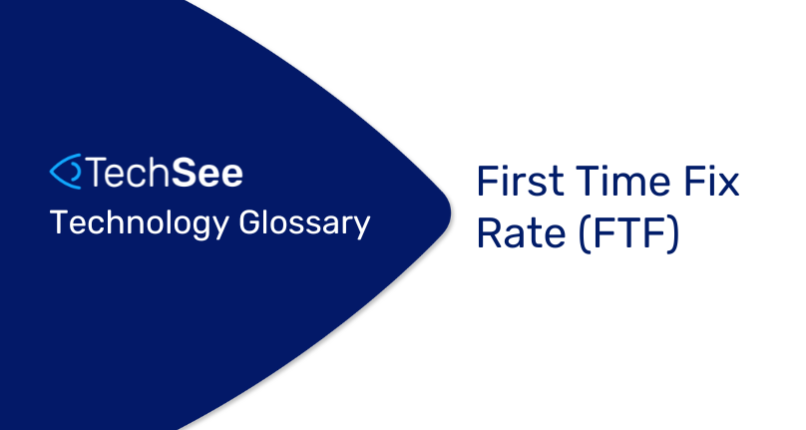What is the First Time Fix Rate (FTF)?
First-time Fix Rate (FTF) is a crucial performance metric in field service, customer service, and technical support. It reflects the percentage of issues resolved on the first interaction with the customer without the need for follow-ups or additional support. A high FTF rate indicates that the service team is effective and efficient, leading to higher customer satisfaction and reduced operational costs.
Role of First-Time Fix Rate in Customer Service and Support
Enhancing Customer Satisfaction: FTF is directly linked to customer satisfaction. When customers’ issues are resolved on the first attempt, it reduces their wait time and frustration. This leads to a more positive customer experience and can foster loyalty and trust in the service provider.
Reducing Operational Costs: A high FTF rate means fewer repeat calls and follow-ups, which in turn reduces the support team’s workload. This efficiency can lead to lower operational costs as the time and resources spent resolving issues are minimized.
Improving Efficiency: By focusing on achieving a high FTF rate, companies can streamline their support processes and improve the overall efficiency of their service operations. This can involve better agent training, improved access to information, and more effective problem-solving tools.
Enhancing Agent and Technician Performance: Tracking FTF rates can help identify areas where agents and technicians excel and where they may need additional training. This data can be used to create targeted training programs and performance improvement plans, ensuring that all agents can resolve issues effectively on the first attempt.
Role of Multisensory and Multimodal AI in Improving FTF
Advanced Diagnostics and Troubleshooting: Multisensory and multimodal AI technologies can significantly enhance support agents’ diagnostic and troubleshooting capabilities. By using AI to analyze text, voice, and visual inputs from customers, support systems can more accurately identify issues and provide detailed, step-by-step solutions that increase the likelihood of a first-time fix.
Agent Assist (Agent CoPilot): AI-powered Agent Assist tools can provide real-time guidance and support to human agents or technicians during customer interactions. These tools can suggest solutions based on historical data, highlight relevant troubleshooting steps, and even offer visual aids. This can empower agents to resolve issues more efficiently and accurately, thereby improving the FTF rate.
AI Agents: AI Agents, equipped with advanced language models and visual AI capabilities, can autonomously handle common customer issues. These virtual agents can provide consistent and accurate responses, troubleshoot problems, and guide customers through solutions, contributing to higher FTF rates.
Capturing and Utilizing Knowledge: Multisensory AI systems can capture and document successful resolutions and troubleshooting steps, creating a rich knowledge base that agents can refer to. This “tribal knowledge” becomes an invaluable resource for improving FTF rates, as it enables agents to leverage past solutions for similar issues.
Importance for Enterprise Decision Makers
For enterprise decision-makers, understanding and improving the First Time Fix Rate is critical for several reasons:
Strategic Advantage: A high FTF rate gives companies a strategic advantage by enhancing customer satisfaction and loyalty. Satisfied customers are more likely to become repeat customers and advocates for the brand.
Operational Efficiency: Improving FTF rates leads to more efficient use of resources, reducing the burden on support teams and lowering operational costs. This efficiency can translate into significant cost savings and better resource allocation.
Performance Measurement: FTF rates are a key performance indicator for customer service teams. By tracking and analyzing FTF rates, companies can measure their support operations’ effectiveness and identify areas for improvement.
Investment in Technology: Understanding the impact of multisensory and multimodal AI on FTF rates can guide investment decisions in AI technology. Companies that leverage these advanced technologies can enhance their service capabilities and stay competitive in the market.
Continuous Improvement: Focusing on FTF encourages continuous improvement in service processes, agent training, and technology integration. This commitment to excellence can drive long-term success and customer satisfaction.
Conclusion
First-time Fix Rate (FTF) is a vital metric in customer service and technical support, reflecting the ability to resolve issues on the first attempt. By leveraging multisensory and multimodal AI technologies, companies can significantly enhance their FTF rates, improving customer satisfaction, reducing operational costs, and increasing efficiency. For enterprise decision-makers, focusing on FTF is essential for strategic planning, performance measurement, and continuous improvement in customer service operations. Understanding and implementing these technologies is crucial for achieving service and customer experience excellence.
To learn more about how TechSee substantially improves First Time Fix Rate (FTF) for the world’s leading brands, please schedule your complimentary consultation today.





